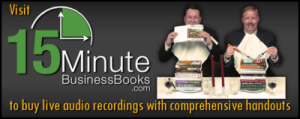 I presented my synopsis of Decisive: How to Make Better Choices in Life and Work by Chip Heath and Dan Heath at the May 3, 2013 First Friday Book Synopsis. Another good book by the Heath brothers! (In earlier First Friday book Synopsis sessions, I presented their first two books, Made to Stick and Switch).
I presented my synopsis of Decisive: How to Make Better Choices in Life and Work by Chip Heath and Dan Heath at the May 3, 2013 First Friday Book Synopsis. Another good book by the Heath brothers! (In earlier First Friday book Synopsis sessions, I presented their first two books, Made to Stick and Switch).
Here are some key lessons that I drew from my reading of this book.
• We need to learn how to use Opportunity Cost:
(If you did this with this money/resource, instead of that, ….)• We need to learn to use the Vanishing Options Test
• You cannot choose any of the current options you’re considering. What else could you do?• We need to (frequently) use Multitracking…
• Consider multiple options simultaneously, not sequentially!
• (But, beware of extreme multitracking, which leads to choice overload)• We need to pay attention to the two “foci”
— a “prevention focus,” which orients us toward avoiding negative outcomes, and a “promotion focus,” which orients us toward pursuing positive outcomes.
• Promotion is better than Prevention for innovation and progress. But, a combination of both is the best approach…• We need to learn from someone else’s good decisions…
• We need to learn to develop, and use, Playlists
- A checklist stops people from making an error; a playlist stimulates new ideas
- A checklist is useful for situations where you need to replicate the same behaviors every time. It’s prescriptive; it stops people from making an error. On the other hand, a playlist is useful for situations where you need a stimulus, a way of producing new ideas. It’s generative; it stops people from overlooking an option.
- We need to beware of Hubris
- Use “intentional” Disagreement to combat Hubris
- We need to learn to use Roger Martin’s question – the “what would have to be true to make it work?” question
- What if our least favorite option were actually the best one? What data might convince us of that?
• We need to conduct Premortems and Preparades
- To prepare for the lower bookend, we need a premortem. “It’s a year from now. Our decision has failed utterly. Why?”
- We need a preparade. “It’s a year from now. We’re heroes. Will we be ready for success?”
• We need to learn to use (a lot of!) analogies
• We need to enable a lot of Bargaining…
• “Bargaining,” which is basically the art of compromise—ensuring that when multiple parties disagree, they horse-trade until they find a solution that most people can live with.• We need to embrace Ooching…
• Ooching = running small experiments to test our theories. Rather than jumping in headfirst, we dip a toe in.
(• Caveat: Ooching is counterproductive for situations that require commitment.)• We need to practice 10/10/10 (the Heath brothers thank Suzy Welch)
• How will we feel about our decision 10 minutes from now? 10 months from now? 10 years from now?
• And here are my six takeaways from the book:
#1 – We need to face the facts. We will make bad decisions “automatically.” We have to “work at it,” to learn how to make good decisions.
#2 – And, as we learn to make “good decisions,” we need to follow an intentional process of good decision making every time we make a substantial decision.
(“As it turned out, process mattered a great deal”).
#3 – Here’s something we can all do, far more often – read books by authors we disagree with; meet with people who disagree with us. Learn to listen to alternative voices – voices that we disagree with.
#4 – Here’s something we can all do, far more often – read books by authors far off our normal radar, from entirely different disciplines. (The best leaders read very, very widely). Seek out seemingly unrelated information, from as far afield as you can journey. It can only broaden your understanding, and give you more ways to “widen your options.”
#5 – Start simply. Simply make use of the “opportunity cost” approach. “What else could I do with this time, this money, these people?”
#6 – And, constantly guard against overconfidence, rising from your own hubris.
{In my next post, I will summarize the “template” that the Heath brothers propose for better decision making – their WRAP Process.}
If you asked me this question: “Randy, do I need to read this book?,” I would answer this way: Read this book if you have a major decision to make, and/or if you want to “train” your decision-making capability. And/or if you need to help others make better decisions. In other words, yes, you probably would benefit greatly from reading this book.
 My synopses of all three of the books by the Heath brothers are (in the case of Decisive, will soon be) available for purchase on our companion site, 15minutebusinessbooks.com. We have our synopses of many other good business book titles also available. Each synopsis comes with our comprehensive handouts, plus the audio recording of our presentation from our live monthly event in Dallas. Give 15minutebusinessbooks.com a try. I think you’ll find it a really useful tool.
My synopses of all three of the books by the Heath brothers are (in the case of Decisive, will soon be) available for purchase on our companion site, 15minutebusinessbooks.com. We have our synopses of many other good business book titles also available. Each synopsis comes with our comprehensive handouts, plus the audio recording of our presentation from our live monthly event in Dallas. Give 15minutebusinessbooks.com a try. I think you’ll find it a really useful tool.
